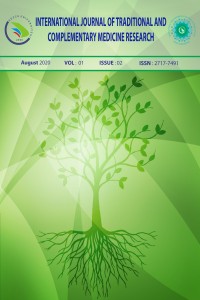Abstract
Objective: Honey samples were collected from 82 different pieces during the season when rhododendron flowers bloomed in Duzce areas in 2017. Since the majority of these honeys collected are sold as mad honey by local people, has been determined that it is the most suitable period to make their analysis.
Material-Method: To apply our sample preparation method, honey samples were prepared to be analyzed on the LC-MS/MS. The accuracy, repeatability and reliability of the analysis method were provided by us.
Results: The obtained results were calculated with the calibration plot drawn at ppb (ng/ml) level in LC-MS/MS. The grayanotoxin -III levels in mad honey were found to be % 36 for 0 ng/ml, %43 for 0.5-10 ng/ml, %15 for 10-50 ng/ml and %6 for 50≥ ng/ml.
Conclusion: Most of honey samples do not contain toxins. Some of them are safe to use in middle proportions and less of them dangerous to consume.
Keywords
References
- Sütlüpınar N, Mat A. Poisoning by toxic honey in Turkey. Arch Toxicol 1993; 67:148-50.
- Baker H.G, Baker I. Studies of nectar-constitution and pollinator-plant coevolution. Coevolution of Animals and Plants, 1975; 100, 591–600.
- Wong J, Youde E, Dickinson B, Hale M. Report of the Rhododendron feasibility study. School of Agricultural and Forest Sciences University of Wales, Bangor Bangor Gwynedd LL57 2UW UK, 2002, pp. 73.
- Tallent WH, Riethof ML, Horning EC. Studies on the occurence and acetylandromedol (andromedotoxin). Journal of the American Chemical Society 1957; 79: 4548-54.
- Asçıoglu M, Özesmi C, Dogan P, Öztürk F. Effects of acute grayanotoxin-I administration on hepatic and renal functions in rats. Turk. J. Med. Sci. 2000; 30, 23–27.
- Onat FY, Yegen BC, Lawrence R, Oktay A, Oktay S. Mad honey poisoning in man and rat. Rev Environ Health 1991; 9(1):3-9.
- Dilber E, Kalyoncu M, Yarıs N, Okten A. A Case of mad honey poisoning presenting with convulsion: intoxication instead of alternative therapy. Turk. J. Med. Sci. 2002; 32, 361–362.
- Gunduz A, Turedi S, Russell RM, Ayaz FA. Clinical review of grayanotoxin/mad honey poisoning past and present. Clinical Toxicology 2008; 46:437-42.
- Küçük M, Kolaylı S, Karaoğlu Ş, Ulusoy E, Baltacı C. Candan F. Biological activities and chemical composition of three honeys of different types from Anatolia. Food Chem. 2007; 100, 526–534.
- Scott, P.M., Coldwell, B.B., Wiberg, G.S. Grayanotoxins. Occurrence and analysis in honey and a comparison of toxicities in mice. Food Cosmet. Toxicol. 1971; 9, 179–184.
- Karakaya AE. Zehirli Barın Grayanotoksin içeriği ve Rhododendron Türleri ile ilişkisinin Araştırılması. Ankara Ecz Fak Mec 1977; 7:111-5.
- Holstege, DM, Puschner B, Le T. Determination of grayanotoxins in biological samples by LC–MS/MS. J. Agr. Food Chem. 2001;49, 1648–1651.
- Sahin H., Turumtay EA, Yildiz O, Kolayli S. Grayanotoxin-III Detection and Antioxidant Activity of Mad Honey. International Journal of Food Properties, 2015;18, 2665–2674.
- Kurtoglu AB, Yavuz R, Evlendilek GA. Characterisation and fate of grayanatoxins in mad honey produced from Rhododendron ponticum nectar. Food Chemistry 2014;161, 47–52.
- Silici S, Yonar ME, Sahin H, Atayoğlu AT, Ozkok D. Analysis of grayanatoxin in Rhododendron honey and effect on antioxidant parameters in rats. Journal of Ethnopharmacology 2014;156, 155–161.
- Akkkaya TS, Ünak P. Determination of Grayanotoxin-III from in Rhodendron Ponticum and Mad Honey Samples by Liquid Chromatography−Mass Spectrometry. Journal of Spectroscopy and Molecular Sciences, 2019; 1 (1), 1-21.
Abstract
References
- Sütlüpınar N, Mat A. Poisoning by toxic honey in Turkey. Arch Toxicol 1993; 67:148-50.
- Baker H.G, Baker I. Studies of nectar-constitution and pollinator-plant coevolution. Coevolution of Animals and Plants, 1975; 100, 591–600.
- Wong J, Youde E, Dickinson B, Hale M. Report of the Rhododendron feasibility study. School of Agricultural and Forest Sciences University of Wales, Bangor Bangor Gwynedd LL57 2UW UK, 2002, pp. 73.
- Tallent WH, Riethof ML, Horning EC. Studies on the occurence and acetylandromedol (andromedotoxin). Journal of the American Chemical Society 1957; 79: 4548-54.
- Asçıoglu M, Özesmi C, Dogan P, Öztürk F. Effects of acute grayanotoxin-I administration on hepatic and renal functions in rats. Turk. J. Med. Sci. 2000; 30, 23–27.
- Onat FY, Yegen BC, Lawrence R, Oktay A, Oktay S. Mad honey poisoning in man and rat. Rev Environ Health 1991; 9(1):3-9.
- Dilber E, Kalyoncu M, Yarıs N, Okten A. A Case of mad honey poisoning presenting with convulsion: intoxication instead of alternative therapy. Turk. J. Med. Sci. 2002; 32, 361–362.
- Gunduz A, Turedi S, Russell RM, Ayaz FA. Clinical review of grayanotoxin/mad honey poisoning past and present. Clinical Toxicology 2008; 46:437-42.
- Küçük M, Kolaylı S, Karaoğlu Ş, Ulusoy E, Baltacı C. Candan F. Biological activities and chemical composition of three honeys of different types from Anatolia. Food Chem. 2007; 100, 526–534.
- Scott, P.M., Coldwell, B.B., Wiberg, G.S. Grayanotoxins. Occurrence and analysis in honey and a comparison of toxicities in mice. Food Cosmet. Toxicol. 1971; 9, 179–184.
- Karakaya AE. Zehirli Barın Grayanotoksin içeriği ve Rhododendron Türleri ile ilişkisinin Araştırılması. Ankara Ecz Fak Mec 1977; 7:111-5.
- Holstege, DM, Puschner B, Le T. Determination of grayanotoxins in biological samples by LC–MS/MS. J. Agr. Food Chem. 2001;49, 1648–1651.
- Sahin H., Turumtay EA, Yildiz O, Kolayli S. Grayanotoxin-III Detection and Antioxidant Activity of Mad Honey. International Journal of Food Properties, 2015;18, 2665–2674.
- Kurtoglu AB, Yavuz R, Evlendilek GA. Characterisation and fate of grayanatoxins in mad honey produced from Rhododendron ponticum nectar. Food Chemistry 2014;161, 47–52.
- Silici S, Yonar ME, Sahin H, Atayoğlu AT, Ozkok D. Analysis of grayanatoxin in Rhododendron honey and effect on antioxidant parameters in rats. Journal of Ethnopharmacology 2014;156, 155–161.
- Akkkaya TS, Ünak P. Determination of Grayanotoxin-III from in Rhodendron Ponticum and Mad Honey Samples by Liquid Chromatography−Mass Spectrometry. Journal of Spectroscopy and Molecular Sciences, 2019; 1 (1), 1-21.
Details
| Primary Language | English |
|---|---|
| Subjects | Traditional, Complementary and Integrative Medicine |
| Journal Section | Research Articles |
| Authors | |
| Publication Date | August 27, 2020 |
| Submission Date | July 7, 2020 |
| Published in Issue | Year 2020 Volume: 1 Issue: 2 |
IJTCMR
International Journal of Traditional and Complementary Medicine Research





